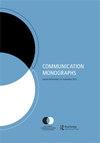Camera perspective and skin color: Biased reactions to viral body worn camera videos of police violence
IF 3.1
2区 文学
Q1 COMMUNICATION
引用次数: 0
Abstract
ABSTRACT Body-worn camera and citizen device videos capturing police use-of-force are shared and commented upon widely within social media. This study investigated how point-of-view (POV: onlooker vs. officer perspective) and citizen skin color (dark skin vs. light skin), interacted to affect emotional responses, likelihood to comment and share, and comment on content. A predominantly White sample watched police use-of-force videos in which citizen skin color and camera POV varied. Body-worn camera (BWC) videos in which light-skinned citizens were harmed elicited the most likelihood to comment and share. Further, experienced negative emotion fully mediated this relationship. BWC videos in which dark-skinned citizens were harmed elicited the least negative emotion, the least likelihood to comment, and less normative commentary about officer behaviors.摄像头视角和肤色:对警察暴力的随身携带摄像头视频的偏见反应
摘要:拍摄警察使用武力的随身摄像头和公民设备视频在社交媒体上被广泛分享和评论。这项研究调查了观点(POV:旁观者与官员的视角)和公民的肤色(深色皮肤与浅色皮肤)如何相互影响情绪反应、评论和分享的可能性以及对内容的评论。以白人为主的样本观看了警察使用武力的视频,视频中公民的肤色和摄像头的视角各不相同。浅色皮肤的公民受到伤害的随身携带的摄像头视频最有可能引起评论和分享。此外,经历过的负面情绪完全介导了这种关系。《生物武器公约》中深色皮肤公民受到伤害的视频引发的负面情绪最少,发表评论的可能性最小,对官员行为的评论也不太规范。
本文章由计算机程序翻译,如有差异,请以英文原文为准。
求助全文
约1分钟内获得全文
求助全文
来源期刊

Communication Monographs
COMMUNICATION-
CiteScore
5.40
自引率
0.00%
发文量
12
期刊介绍:
Communication Monographs, published in March, June, September & December, reports original, theoretically grounded research dealing with human symbolic exchange across the broad spectrum of interpersonal, group, organizational, cultural and mediated contexts in which such activities occur. The scholarship reflects diverse modes of inquiry and methodologies that bear on the ways in which communication is shaped and functions in human interaction. The journal endeavours to publish the highest quality communication social science manuscripts that are grounded theoretically. The manuscripts aim to expand, qualify or integrate existing theory or additionally advance new theory. The journal is not restricted to particular theoretical or methodological perspectives.
 求助内容:
求助内容: 应助结果提醒方式:
应助结果提醒方式:


